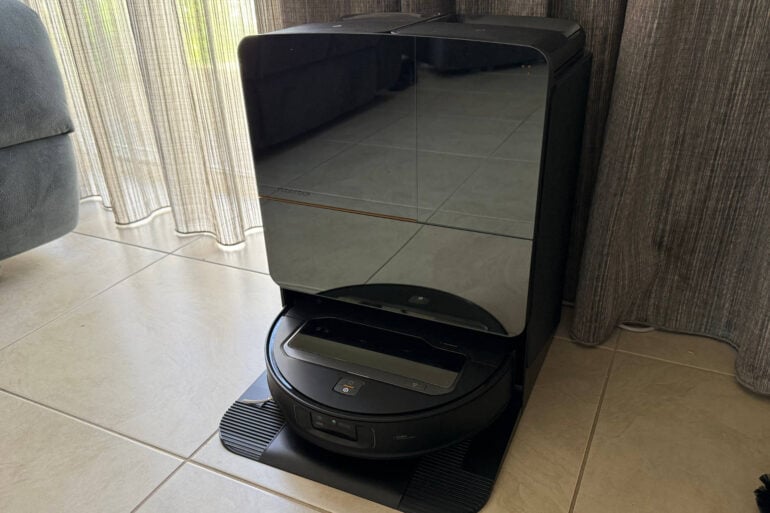
At the expensive end of the technology spectrum, you get to play with experimental features before one of two things happens. One is that it eventually trickles down to more affordable gadgets in the following years. Alternatively, it’s a one-and-done deal that gets shelved, confined to the annals of history. I’m not yet sure where the Roborock Saros Z70 falls on this spectrum.
For the most part, the Saros Z70 is a competent high-end robot cleaner that follows all conventions set before it. Where it differs is through the inclusion of a retractable mechanical arm that picks up objects in its way.
It’s a device that has a clear use case. Robot vacuums are great, but usually require a relatively tidy floor to begin with. What if you didn’t need to pick everything up off the floor before setting the robot to work? That’s the question the Saros Z70 attempts to answer.
In its current iteration, the Roborock Saros Z70 does most things right. If you don’t count its main point of difference, that is. As good as a clutter-tackling arm sounds in theory, its sporadic real-world performance doesn’t justify its steep $3,999 price tag.
Table of contents
- Design and setup
- What’s the difference between the Saros Z70 and Saros 10?
- Specifications and price
- Cleaning
- Robotic arm
- Who is the Roborock Saros Z70 for?
Design and setup
From the outside, the Roborock Saros Z70 looks like any other high-end robot cleaner. It’s a circular device with a fair bit of heft, accompanied by a large docking station. That docking station just happens to be highly reflective, showing up any speck of dust and fingerprints left behind — an odd choice for a cleaning appliance.
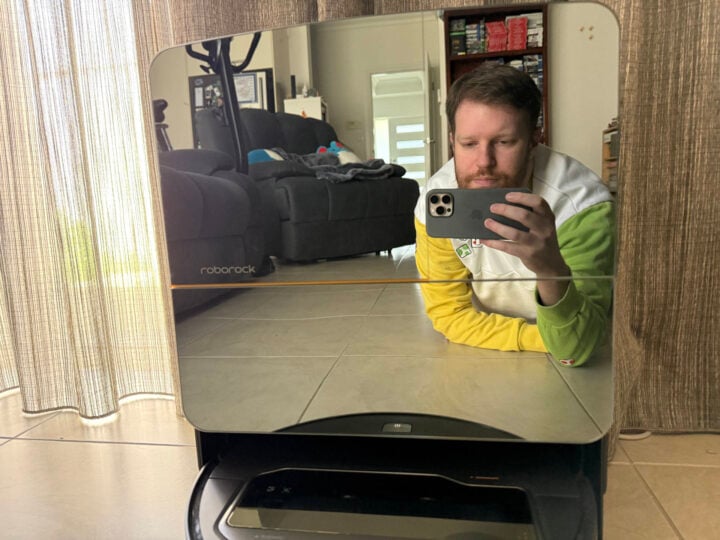
But the main attraction — the mechanical arm — is hidden away in a compartment on top of the robot. When activated (more on that later), the hatch pops open, and the arm extends outward. If anything goes wrong, the robot has an emergency stop button. Fortunately, it’s not a button I had to press during my testing.
From my experience testing robot vacuums, Roborock has consistently led the way in navigation. The Saros Z70 continued that trend, producing a map of my home quickly. From there, it had no issues navigating the plethora of chair legs and furniture throughout the house.
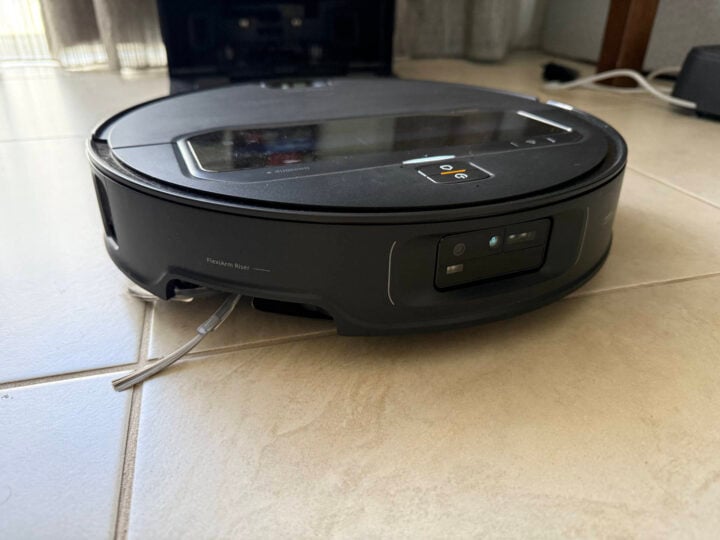
As a result of its navigation smarts, the robot creates a detailed 3D map of each room. More than just a pretty-looking picture, it’s handy seeing how tall each bit of furniture sits, indicating where the robot can and can’t go.
What’s the difference between the Saros Z70 and Saros 10?
Looking at the name of any given appliance doesn’t provide much information about what it does or where it sits in the pecking order. What does the Saros Z70 mean compared to the Saros 10? Or, just to throw another variable into the mix, what about the Saros 10R?
Let’s look at the pricing first:
- Saros Z70: $3,999
- Saros 10: $2,999
- Saros 10R: $2,899
Obviously, we’re dealing with the flagship range here. Roborock’s top-of-the-line robot cleaners don’t come cheap. To make the comparison as simple as possible, here’s an easy way to think of each model: the Z70 is the mechanical arm model, the 10 is the vacuuming specialist, while the 10R is the mopping specialist.
All three Saros robots come with Roborock’s fancy all-in-one self-cleaning docking station. Here, each robot can empty its contents automatically, while the docking station uses hot water to wash the mopping pads.
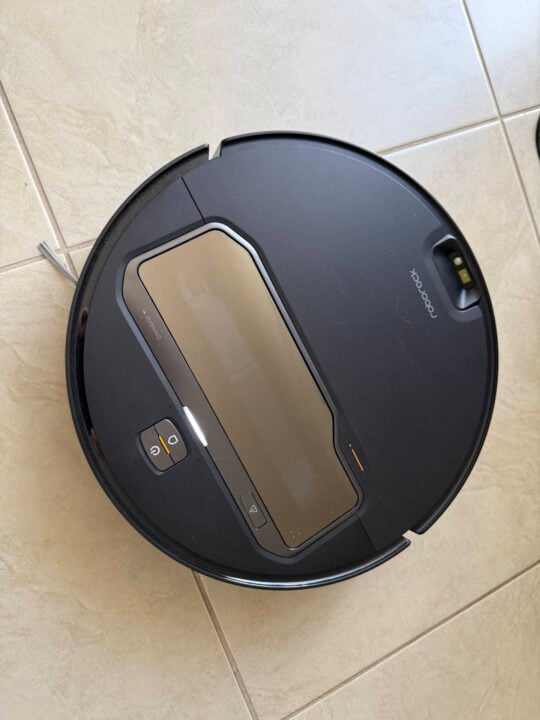
With the Saros Z70, Roborock combines the higher 22,000Pa suction power of the Saros 10 (the 10R has a slightly lower 19,000Pa suction power rating) with the dual spinning mops of the 10R.
However, because of the mechanical arm, the Saros Z70 has less space for storing dust and water. If you look at the Saros 10, it has a 270ml dustbin and a 100ml water tank. That’s larger built-in compartments than the Saros Z70, which only has a 180ml dustbin and a 69ml water tank.
In reality, that’s not a big deal. All it means is that the most expensive robot needs to return to base more often. Considering the point of high-end robots is to automate cleaning, there should be no tangible difference in your daily use.
For $1,000 more than its robot companions, the Saros Z70 combines most of the tech used by the other Saros models into one device. But you’re really paying for the mechanical arm.
Roborock Saros Z70 specifications and price
| Size | Robot: 350 x 353 x 79.8 mm Docking station: 381 x 475 x 488 mm |
| Suction power | 22,000Pa |
| Mopping | Dual spinning removable mop pads Extendable mop |
| Docking station features | Auto dust emptying Clean and dirty water tanks Hot water mop washing Hot air mop drying |
| Battery | 6,400mAh Up to 180-minute runtime |
| Mechanical arm features | Retractable OmniGrip mechanical arm Can pick up small objects up to 300g |
| Price (RRP) | $3,999 |
| Warranty | Two years |
| Official website | Roborock Australia |
Cleaning
With all the fuss about a mechanical arm, the Saros Z70’s cleaning capabilities almost feel like a footnote. Fortunately, its core functionality does exactly what you’d expect it to.
Vacuuming up crumbs, dust, and pet fluff was easy. The Saros Z70 had no trouble with the dry stuff. How it handled the wet stuff was less impressive.
As I usually do, I spread a few different messes on the kitchen floor, including some flour, a streak of margarine, and a smear of Vegemite. With its mops in action and left to do a regular cleaning run, the Roborock Saros Z70 struggled.
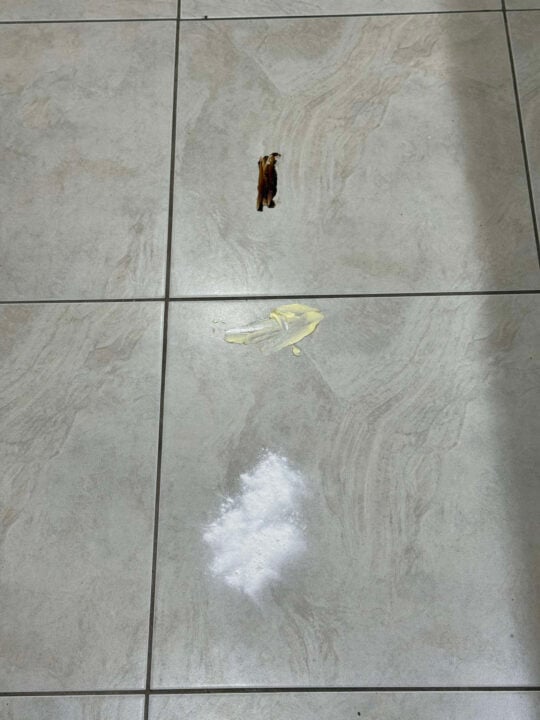
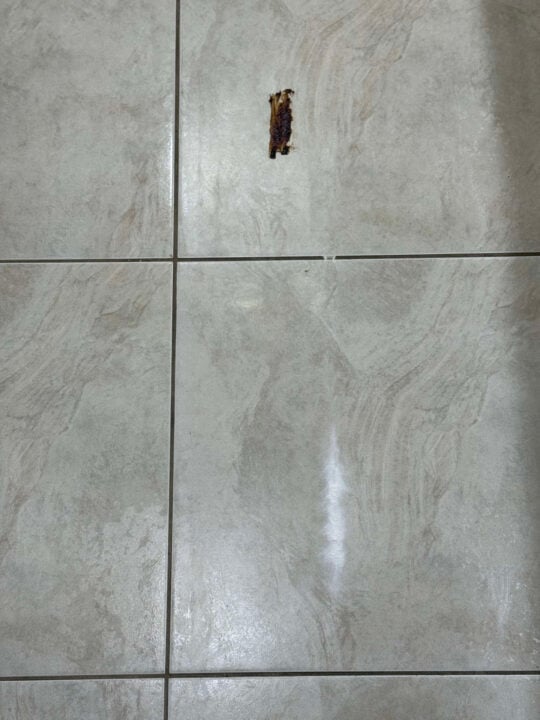
It picked up most of the flour and most of the margarine. Of the latter, it spread the margarine around a bit, getting some stuck in the grout between the tiles, which I had to manually clean later. Unfortunately, the mop failed to make much of a dent in the Vegemite mess.
Part of that is because robot cleaners don’t apply much pressure when mopping. But the Saros Z70 was less capable of mopping up messes than the $2,499 Ecovacs Deebot X8 Pro Omni, which is considered a mopping specialist.
One thing in Roborock’s favour is its extendable mop. For daily maintenance and light cleaning, the mop gets as close to edges as possible because the mop reaches out to clean tight spaces. Another nicety is that when sent on a vacuum-only run, the Saros Z70 removes its mopping pads entirely, removing any risk of dragging wet mops over carpets.
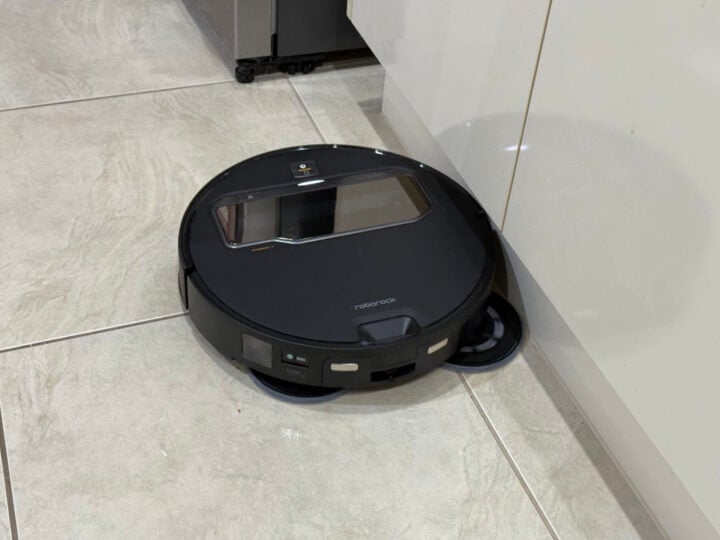
Again, robot cleaners are best at daily maintenance, not deep cleaning. Even with that considered, the Roborock Saros Z70 is better at vacuuming than it is mopping.
Robotic arm
In theory, a robot cleaner having a mechanical arm is a sound idea. You can’t clean a surface properly if something’s in the way, right? That’s the core thesis of the Saros Z70’s arm: when it detects a small object, the arm extends out, moves it out of the way, and then retracts the arm before continuing on its merry way.
By design, the arm doesn’t activate automatically. You need to enable it via the Roborock app, after you’ve sent the robot on a few cleaning runs to familiarise it with its surroundings.
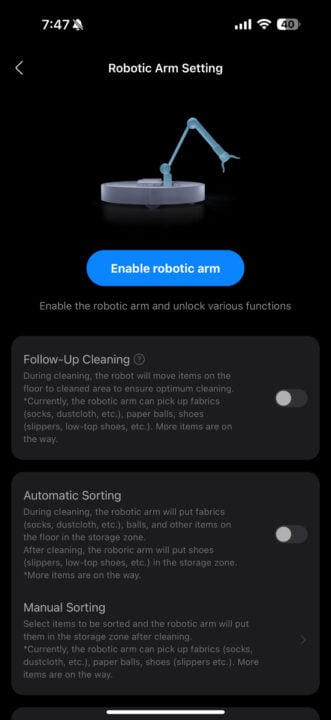
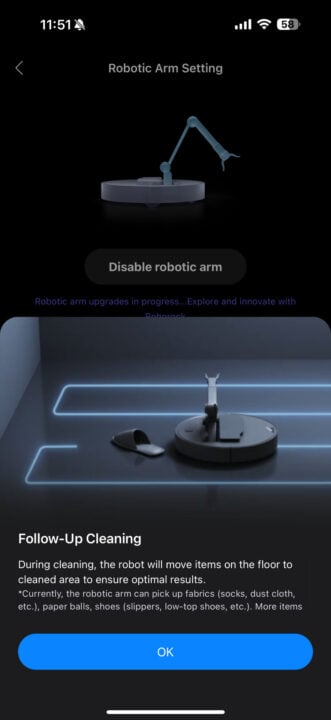
Included with the robot is a small box you can set as a storage bin, which is where it can drop off small objects, like toys on the floor. Larger items, like slippers, need a separate drop-off point.
But for an appliance that puts its mechanical arm front and centre, there sure are a lot of provisos. As painstakingly outlined in the user manual, there is a set of conditions in which the Saros Z70’s arm is meant to thrive.
For one, it’s only capable of picking up objects weighing 300 grams or less. That’s fair enough, it’s only a relatively small appliance. But the subsequent laundry list of conditions defeats much of the purpose of having an arm that alleges to declutter the floor.
To give you the short version of the 16-page guide solely dedicated to the arm’s operation, here are some of the main instructions:
- Socks, paper and tissues must be scrunched up
- Shoes light enough to be picked up must face away from walls
- Footwear cannot be picked up on carpeted floors
- Only use the robot to pick up slippers, not sneakers
By the time you follow all the instructions, you might as well just put the things away yourself. It’s an early example of the technology, so while the idea is there, the execution still has room for improvement.
Arm wrestling
Even after factoring in every condition, my testing of the Roborock Saros Z70 revealed the arm to be its weakness. In a deliberately set-up obstacle course filled with scrunched-up paper, a pair of slides, and various cat toys, the robot failed to detect most objects.
Or, perhaps more accurately, it failed to detect most objects as something it could pick up and put away. In one instance, the robot identified a soft cat toy as pet waste instead, subsequently giving it a wide berth.
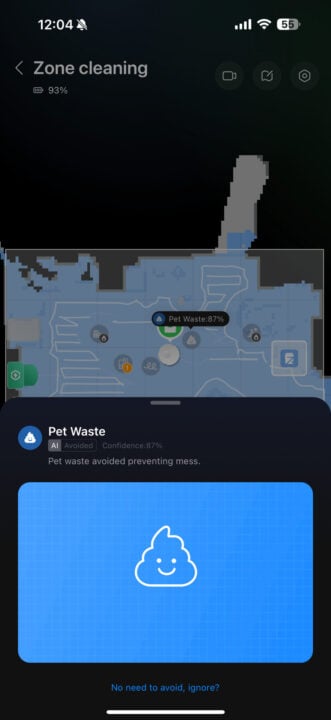
On the couple of occasions the Saros Z70 correctly identified objects, I admit to being mesmerised by the cleaning process. Upon detecting an object, the robot’s hatch opened as the arm slowly whirred to life out of its cage. Then, it slowly reached out to grasp its target, pincers gently clamping down.
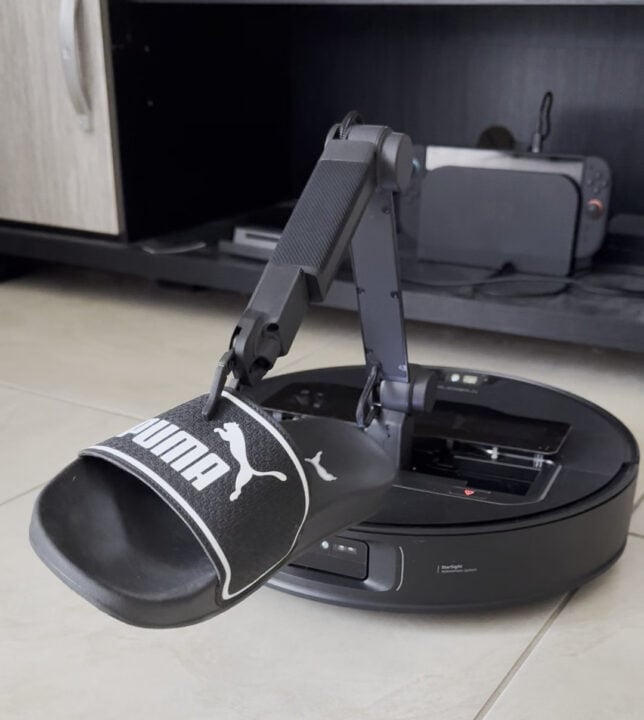
With the robot’s payload in its clutches, it slowly moved to a drop-off point previously designated in the Roborock app. Finally, it completed the process in reverse, dropping its contents before slowly retracting the arm back into its body.
The mechanical arm is a fun novelty, but is too unreliable to be a consistently useful feature. Often, a lot of goofy-looking technologies end up being great accessibility tools. I can see an improved and cheaper version of the technology helping elderly users or people with disabilities and chronic illnesses keep clutter off the floor.
For now, however, it’s a gimmick not ready for the mass market.
Who is the Roborock Saros Z70 for?
Ultimately, the Roborock Saros Z70 is a robot cleaner for people who simply must have the latest technology, effectiveness be damned. It cleans well, but not $1,000 better than the next model down.
That nearly $4,000 price tag is solely due to the mechanical arm. It’s a novelty when it works, which is intermittent. I’ve seen the Saros Z70 on sale for $3,299, which is then offset by a similar discount applied to the Saros 10, which is a more affordable and reliable robot vacuum.
The post Roborock Saros Z70 review: Reach out and touch mess appeared first on GadgetGuy.



0 (mga) komento:
Mag-post ng isang Komento